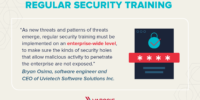Welcome to the digital battleground, where cybersecurity threats loom large. Handling these threats swiftly is crucial to safeguarding your organization’s sensitive information and maintaining a robust security posture. In this article, we’ll explore quick tips for effective cyber threat triage, helping you navigate the cybersecurity landscape with agility and resilience.
The Cybersecurity Storm: Understanding the Threat Landscape ️
Before diving into threat triage, it’s essential to understand the cybersecurity storm you’re facing. Stay informed about the latest threat vectors, attack methodologies, and vulnerabilities relevant to your organization. A comprehensive understanding of the threat landscape forms the foundation for effective cyber threat triage.
Real-time Monitoring: Keeping a Watchful Eye ️
Keep a watchful eye on your digital assets through real-time monitoring. Utilize advanced security information and event management (SIEM) tools to detect anomalies and potential threats in real-time. Immediate awareness allows for prompt action, reducing the dwell time of attackers within your network.
Incident Response Plan: Preparing for Battle
Prepare for battle with a well-defined incident response plan. Establish clear procedures for identifying, containing, eradicating, recovering, and learning from security incidents. A robust incident response plan is your playbook for navigating cyber threats, ensuring a coordinated and effective response.
Threat Intelligence Integration: Augmenting Defenses with Knowledge
Augment your defenses with threat intelligence integration. Leverage up-to-date threat intelligence feeds to enhance your understanding of emerging threats. Integrate threat intelligence into your security infrastructure to proactively defend against known threats and anticipate potential risks.
Automated Response Mechanisms: Swift and Precise Counteractions ⚙️
Implement automated response mechanisms for swift and precise counteractions. Leverage security orchestration, automation, and response (SOAR) tools to automate repetitive tasks and responses to common threats. Automation ensures a rapid and consistent reaction to security incidents, minimizing manual intervention.
Prioritization Frameworks: Focusing on Critical Threats
Establish prioritization frameworks to focus on critical threats. Not all threats are equal, and prioritizing based on severity, potential impact, and relevance to your organization is essential. This allows you to allocate resources effectively and address the most pressing cybersecurity concerns first.
Cross-functional Collaboration: Uniting Forces
Unite forces through cross-functional collaboration. Cybersecurity is a collective effort that involves IT, legal, communications, and executive teams. Foster a collaborative culture where information flows seamlessly, enabling a coordinated response to cyber threats from all facets of your organization.
Continuous Training: Sharpening the Cyber Defense Skills
Sharpen your cyber defense skills through continuous training. Cyber threats evolve, and so should your team’s knowledge and expertise. Invest in regular training sessions, tabletop exercises, and simulations to keep your cybersecurity team well-prepared and agile in the face of emerging threats.
Post-Incident Analysis: Learning from the Battlefield
Learn from the battlefield through post-incident analysis. After a security incident is resolved, conduct a thorough analysis to understand the attack vectors, entry points, and areas for improvement. This continuous learning approach strengthens your cybersecurity defenses and prepares you for future threats.
Regulatory Compliance: Navigating Legal Waters
Navigate legal waters by ensuring regulatory compliance. Understand the cybersecurity regulations applicable to your industry and location. Complying with regulations not only helps avoid legal consequences but also ensures a baseline level of security that aligns with industry standards.
Conclusion: Standing Strong Against the Cyber Onslaught
In the ever-changing landscape of cybersecurity, swift and effective threat triage is the key to standing strong against the cyber onslaught. By understanding the threat landscape, implementing real-time monitoring, having a well-defined incident response plan, integrating threat intelligence, automating responses, prioritizing effectively, fostering cross-functional collaboration, investing in continuous training, conducting post-incident analysis, and ensuring regulatory compliance, you’re not just defending your digital assets – you’re fortifying your organization against the relentless waves of cyber threats. May your cybersecurity defenses be resilient, your response strategies be agile, and your organization stand strong against the challenges of the digital battlefield!








